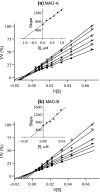The evaluation of 1-tetralone and 4-chromanone derivatives as inhibitors of monoamine oxidase
- PMID: 32970293
- PMCID: PMC7512223
- DOI: 10.1007/s11030-020-10143-w
The evaluation of 1-tetralone and 4-chromanone derivatives as inhibitors of monoamine oxidase
Abstract
Monoamine oxidase (MAO) is of much clinical relevance, and inhibitors of this enzyme are used in the treatment for neuropsychiatric and neurodegenerative disorders such as depression and Parkinson's disease. The present study synthesises and evaluates the MAO inhibition properties of a series of 33 1-tetralone and 4-chromanone derivatives in an attempt to discover high-potency compounds and to expand on the structure-activity relationships of MAO inhibition by these classes. Among these series, eight submicromolar MAO-A inhibitors and 28 submicromolar MAO-B inhibitors are reported, with all compounds acting as specific inhibitors of the MAO-B isoform. The most potent inhibitor was a 1-tetralone derivative (1h) with IC50 values of 0.036 and 0.0011 µM for MAO-A and MAO-B, respectively. Interestingly, with the reduction of 1-tetralones to the corresponding alcohols, a decrease in MAO inhibition potency is observed. Among these 1-tetralol derivatives, 1p (IC50 = 0.785 μM) and 1o (IC50 = 0.0075 μM) were identified as particularly potent inhibitors of MAO-A and MAO-B, respectively. Potent compounds such as those reported here may act as leads for the future development of MAO-B specific inhibitors. The present study describes the MAO inhibitory activities of a series of 1-tetralone and 4-chromanone derivatives. Numerous high-potency MAO-B specific inhibitors were identified.
Keywords: 1-Tetralone; 4-Chromanone; Inhibition; Monoamine oxidase; Parkinson’s disease.
Conflict of interest statement
The authors declare that they have no conflict of interest.
Figures






Similar articles
-
Synthesis and Evaluation of 2-benzylidene-1-tetralone Derivatives for Monoamine Oxidase Inhibitory Activity.Cent Nerv Syst Agents Med Chem. 2018;18(2):136-149. doi: 10.2174/1871524918666180501121638. Cent Nerv Syst Agents Med Chem. 2018. PMID: 29714148
-
The inhibition of catechol O-methyltransferase and monoamine oxidase by tetralone and indanone derivatives substituted with the nitrocatechol moiety.Bioorg Chem. 2021 Sep;114:105130. doi: 10.1016/j.bioorg.2021.105130. Epub 2021 Jun 28. Bioorg Chem. 2021. PMID: 34225162
-
α-Tetralone derivatives as inhibitors of monoamine oxidase.Bioorg Med Chem Lett. 2014 Jun 15;24(12):2758-63. doi: 10.1016/j.bmcl.2014.04.021. Epub 2014 Apr 16. Bioorg Med Chem Lett. 2014. PMID: 24794105
-
Structural Exploration of Synthetic Chromones as Selective MAO-B Inhibitors: A Mini Review.Comb Chem High Throughput Screen. 2017;20(6):522-532. doi: 10.2174/1386207320666170227155517. Comb Chem High Throughput Screen. 2017. PMID: 28245770 Review.
-
Revealing the role of the benzyloxy pharmacophore in the design of a new class of monoamine oxidase-B inhibitors.Arch Pharm (Weinheim). 2022 Aug;355(8):e2200084. doi: 10.1002/ardp.202200084. Epub 2022 May 13. Arch Pharm (Weinheim). 2022. PMID: 35567313 Review.
Cited by
-
Regioselective Oxidation of Tetrahydronaphthalenes to α-Tetralone Derivatives Using DDQ as Oxidizing Agent: Synthesis and Evaluation of Antibacterial and Antifungal Activities.ACS Omega. 2024 Sep 12;9(38):39344-39352. doi: 10.1021/acsomega.4c02130. eCollection 2024 Sep 24. ACS Omega. 2024. PMID: 39346887 Free PMC article.
-
One-Pot Regio- and Diastereoselective Gold-Catalyzed Propargylation of in Situ Activated Chromones and Consecutive Cyclization.Org Lett. 2024 Dec 13;26(49):10487-10492. doi: 10.1021/acs.orglett.4c03812. Epub 2024 Nov 28. Org Lett. 2024. PMID: 39607952 Free PMC article.
References
MeSH terms
Substances
Grants and funding
LinkOut - more resources
Full Text Sources

